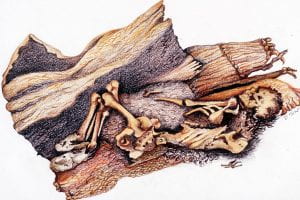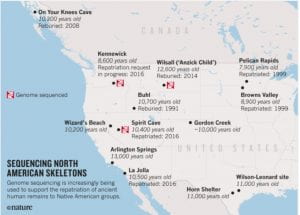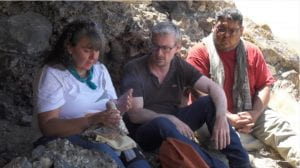It is now October, and Halloween is quickly approaching. This means tricks, treats, and a lot of scary monsters. One such monster is the infamous mummy! While mummies are usually associated with the cloth wrapped ones in the pyramids of Egypt, mummies can be found all over the world. The United States has its own share of mummies including the Spirit Cave Mummy found in the 1940s in Nevada. What distinguishes the Spirit Cave Mummy from those of Egypt is that it is a natural mummy, meaning that humans did not dehydrate and preserve this person as they do in Egypt. In fact, radiocarbon dates determined that the Spirit Cave Mummy is 10,600 years old making it the oldest naturally created mummy. While his age is extremely interesting for archaeology, it is actually his DNA and the issues surrounding his repatriation to the Fallon Paiute-Shoshone Tribe that are most informative.

Spirit Cave has long been claimed as ancestral land by the Fallon Paiute-Shoshone Tribe of Nevada. The discovery of a set of mummified remains in this cave would further their claim on the land. The mummy, discovered by Georgia and Sydney Wheeler in 1940, was determined a 40-year-old male who

Drawing of the Spirit Cave Mummy as he was discovered.
was wrapped in a rabbit-skin blanket and reed mats. He was also wearing moccasins and associated with three other individual remains all of which were either cremated or partial. Originally the Wheelers dated the remains to be 1,500-2,000 years ago, however, carbon dating revealed that they dated back to 10,600 years ago. Of course, the tribe wanted both the remains and associated artifacts to be returned for reburial. According to the Native American Grave Protection and Repatriation Act (NAGPRA), the tribe should have been given the remains back. However, the Bureau of Land Management (BLM) decided against this action in 2000. In 2006, the tribe sued the government but all that led to was the US District Court ordering BLM to reconsider their decision.
The mummy was stored in the Nevada

DNA sequencing project conducted on various controversial remains throughout North America
museum and only available for limited research to determine ancestry. Anthropologists Douglas Owsley and Richard Jantz examined the remains and only determined that the mummy’s skull was a different shape than current First Nations people’s. The BML, with reluctant agreement from the Tribe, decided to allow DNA analysis to be conducted. In 2015, evolutionary geneticist Eske Willerslev from the Natural History Museum of Denmark conducted the analysis and discovered that the mummy was more closely related to modern North and South American indigenous groups than another other modern population. The remains were repatriated to the Fallon Paiute-Shoshone in 2016 and given a private burial in 2018.
While valuable information about the movement of early humans in the Americas was gained through the DNA analysis of the Spirit Cave Mummy, it brings up an important issue surrounding the implementation of NAGPRA. NAGPRA states that human remains should be returned to tribes who have a geographical association with the burial. Even more DNA, the tribe had claim to the remains and the remains should have been returned when the tribe requested the action. However, the problem with repatriating remains as old as the mummy is that it is difficult to prove that they are in fact First Nation. We know so little about the early inhabitants of the continent that it is possible some remains discovered are entirely unrelated to the modern First Nations. This problem was easily remedied through DNA analysis and the technique is likely to be employed on other controversial remains. But the next question is does DNA relation to modern people actually matter in such a context? The Spirit Cave Mummy’s DNA showed that he was actually more closely related to peoples from South America. While some might say it does if the person is actually a relative, others may believe that everyone who inhabited the land before them is their ancestor. This question is better left to the tribes.
Sources: https://www.history.com/news/oldest-mummy-discovery-spirit-cave-shoshone; https://www.nature.com/news/north-america-s-oldest-mummy-returned-to-us-tribe-after-genome-sequencing-1.21108; https://www.biotechniques.com/news/resolving-lawsuits-and-revealing-humanitys-genomic-history/
Follow IUP Anthropology on Facebook, Twitter, and Instagram

Dear Rachel,
Can you steer me to more research of what South American regions the Spirit Cave Mummy was affiliated to genetically?
Thank you so much for your article here. Very informative.